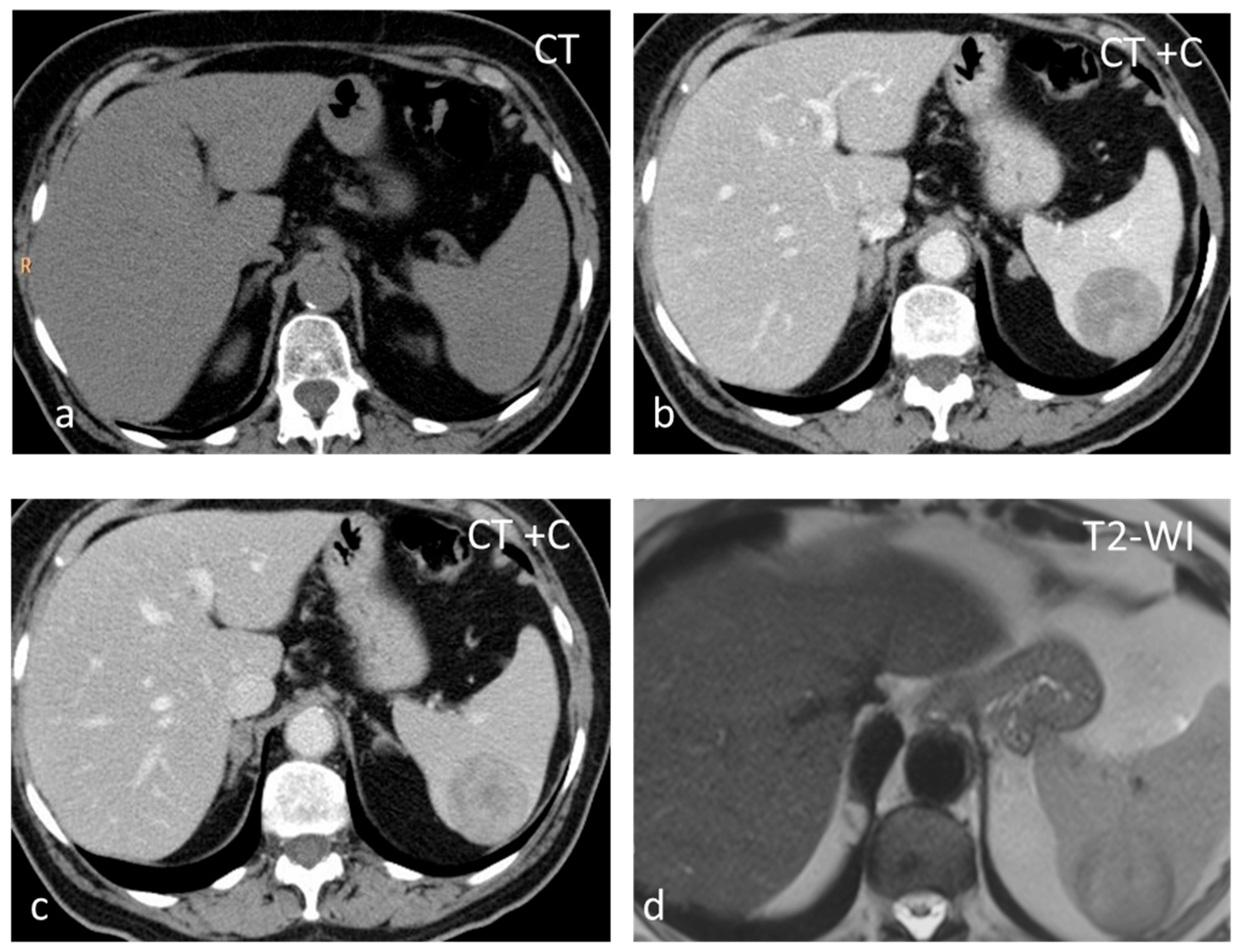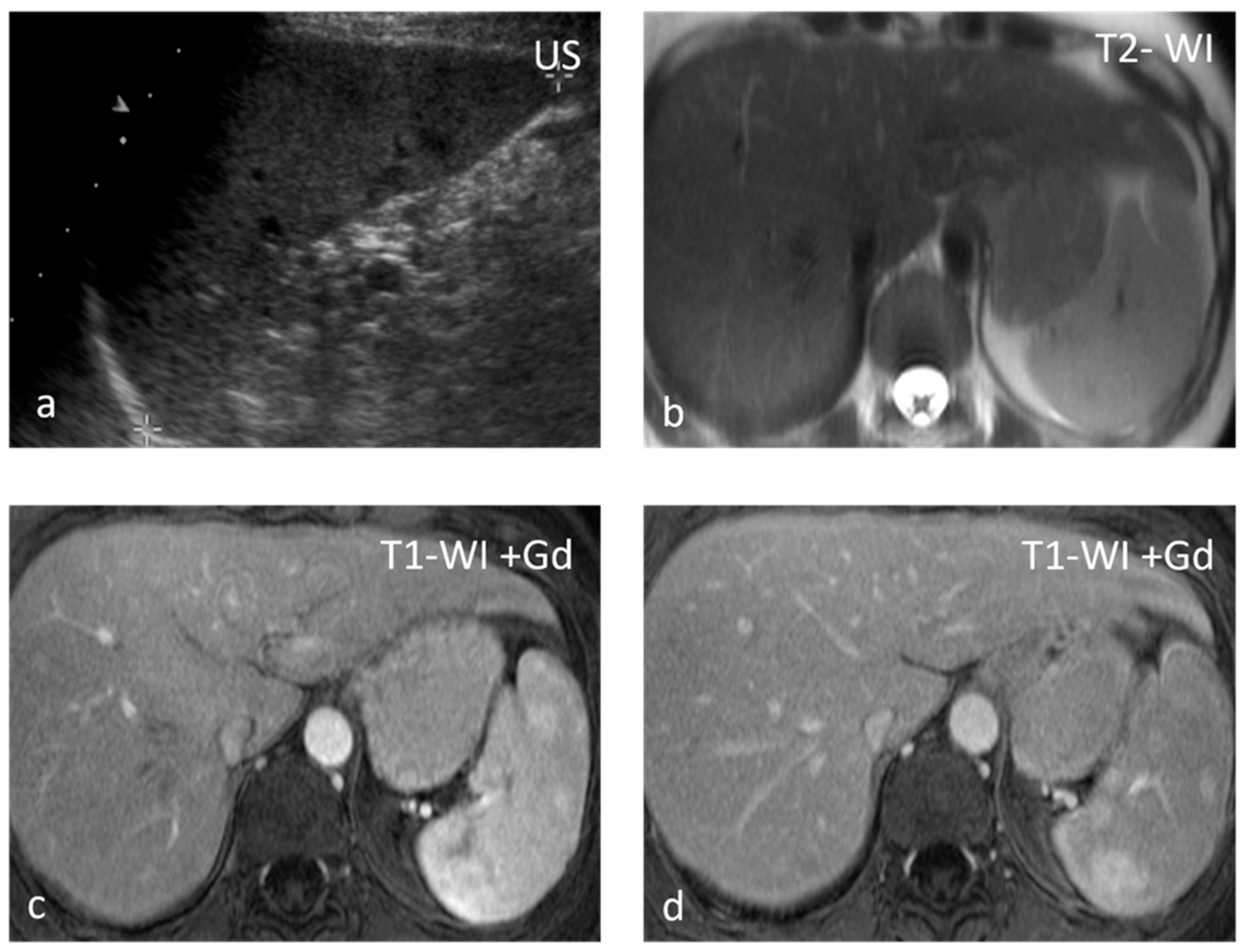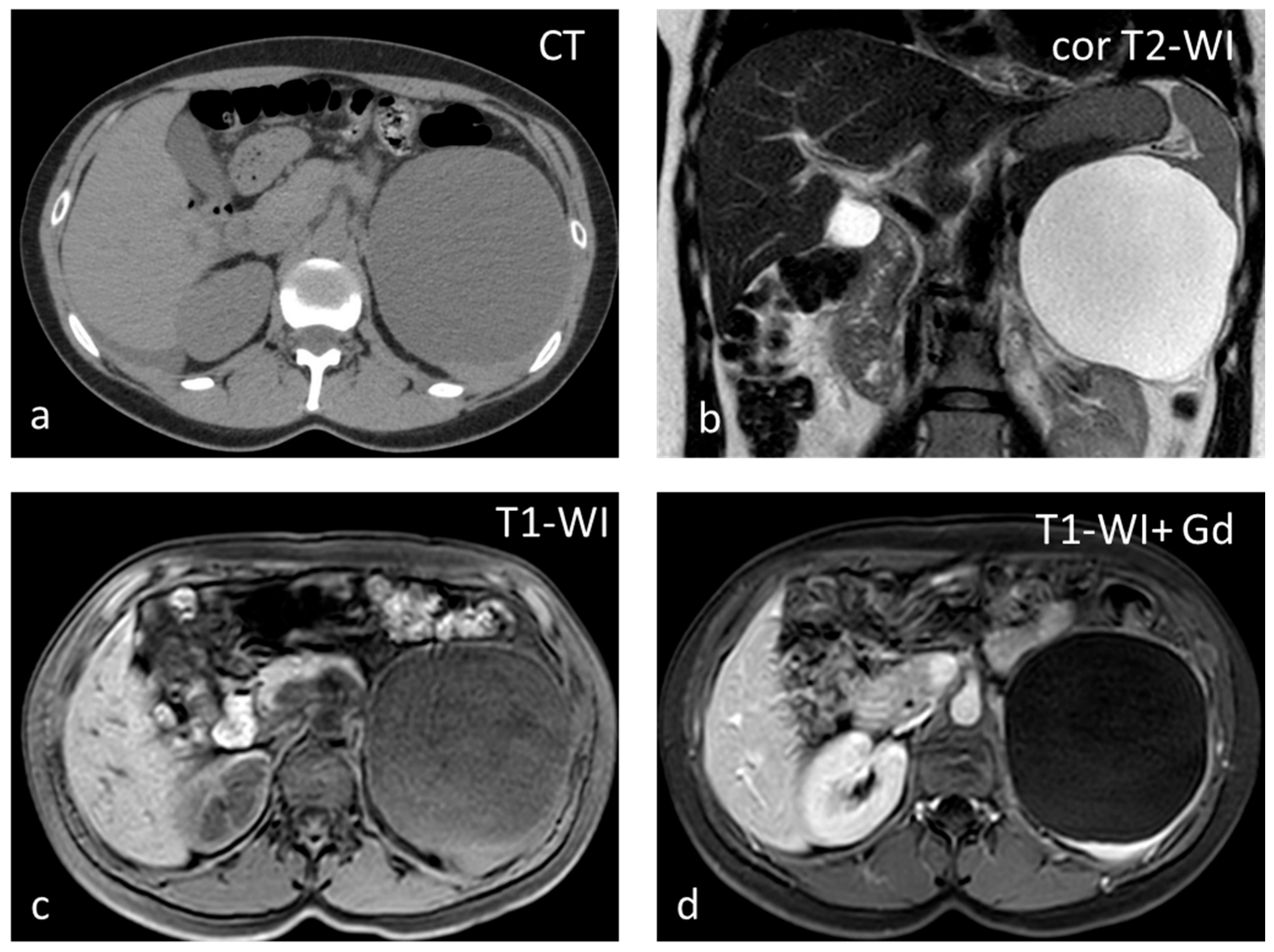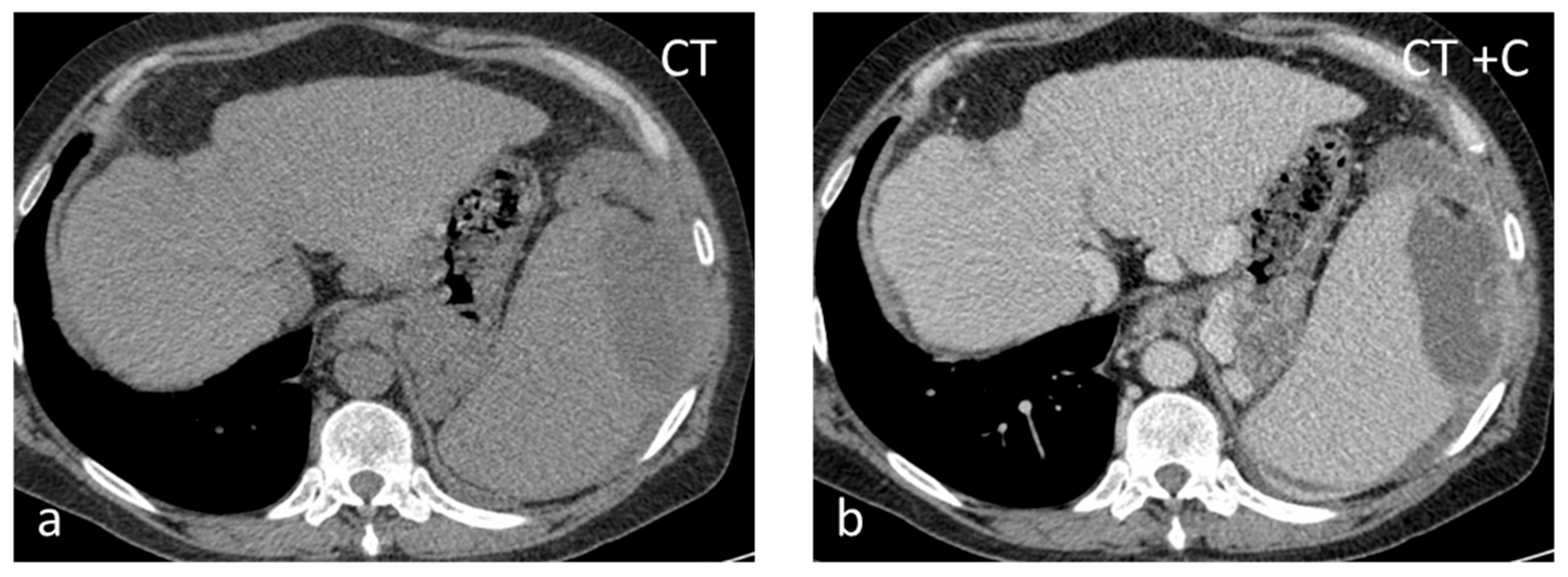The Spectrum of Solitary Benign Splenic Lesions—Imaging Clues for a Noninvasive Diagnosis
Abstract
1. Introduction
2. Normal Splenic Appearances with Different Imaging Modalities
2.1. US
2.2. CT
2.3. MRI
2.4. Nuclear Medicine
3. Lesion-Specific Imaging Characteristics
4. Conclusions
Funding
Conflicts of Interest
References
- Hegenscheid, K.; Seipel, R.; Schmidt, C.O.; Völzke, H.; Kühn, J.-P.; Biffar, R.; Kroemer, H.K.; Hosten, N.; Puls, R. Potentially relevant incidental findings on research whole-body MRI in the general adult population: Frequencies and management. Eur. Radiol. 2013, 23, 816–826. [Google Scholar] [CrossRef]
- Ekeh, A.P.; Walusimbi, M.; Brigham, E.; Woods, R.J.; McCarthy, M.C. The Prevalence of Incidental Findings on Abdominal Computed Tomography Scans of Trauma Patients. J. Emerg. Med. 2010, 38, 484–489. [Google Scholar] [CrossRef] [PubMed]
- Jang, S.; Kim, J.H.; Hur, B.Y.; Ahn, S.J.; Joo, I.; Kim, M.J.; Han, J.K. Role of CT in Differentiating Malignant Focal Splenic Lesions. Korean J. Radiol. 2018, 19, 930–937. [Google Scholar] [CrossRef]
- Stang, A.; Keles, H.; Hentschke, S.; von Seydewitz, C.U.; Dahlke, J.; Malzfeldt, E.; Braumann, D. Differentiation of Benign from Malignant Focal Splenic Lesions Using Sulfur Hexafluoride–Filled Microbubble Contrast-Enhanced Pulse-Inversion Sonography. Am. J. Roentgenol. 2009, 193, 709–721. [Google Scholar] [CrossRef]
- Iacobellis, F.; Schillirò, M.L.; Di Serafino, M.; Borzelli, A.; Grimaldi, D.; Verde, F.; Caruso, M.; Orabona, G.D.; Rinaldo, C.; Sabatino, V.; et al. Multimodality ultrasound assessment of the spleen: Normal appearances and emergency abnormalities. J. Clin. Ultrasound 2023, 51, 543–559. [Google Scholar] [CrossRef] [PubMed]
- Yoshikawa, T.; Kawamitsu, H.; Mitchell, D.G.; Ohno, Y.; Ku, Y.; Seo, Y.; Fujii, M.; Sugimura, K. ADC Measurement of Abdominal Organs and Lesions Using Parallel Imaging Technique. Am. J. Roentgenol. 2006, 187, 1521–1530. [Google Scholar] [CrossRef]
- Jang, K.M.; Kim, S.H.; Hwang, J.; Lee, S.J.; Kang, T.W.; Lee, M.W.; Choi, D. Differentiation of Malignant from Benign Focal Splenic Lesions: Added Value of Diffusion-Weighted MRI. Am. J. Roentgenol. 2014, 203, 803–812. [Google Scholar] [CrossRef]
- Choi, S.Y.; Kim, S.H.; Jang, K.M.; Kang, T.; Song, K.D.; Moon, J.Y.; Choi, Y.H.; Lee, B.R. The value of con-trast-enhanced dynamic and diffusion-weighted MR imaging for distinguishing benign and malignant splenic masses. Br. J. Radiol. 2016, 89, 20160054. [Google Scholar] [CrossRef] [PubMed]
- Cheng, G.; Alavi, A.; Lim, E.; Werner, T.J.; Del Bello, C.V.; Akers, S.R. Dynamic Changes of FDG Uptake and Clearance in Normal Tissues. Mol. Imaging Biol. 2013, 15, 345–352. [Google Scholar] [CrossRef]
- Sugawara, Y.; Zasadny, K.R.; Kison, P.V.; Baker, L.H.; Wahl, R.L. Splenic fluorodeoxyglucose uptake increased by granulocyte colony-stimulating factor therapy: PET imaging results. J. Nucl. Med. 1999, 40, 1456–1462. [Google Scholar] [PubMed]
- Liu, Y. Clinical significance of diffusely increased splenic uptake on FDG-PET. Nucl. Med. Commun. 2009, 30, 763–769. [Google Scholar] [CrossRef] [PubMed]
- Metser, U.; Even-Sapir, E. The Role of 18F-FDG PET/CT in the Evaluation of Solid Splenic Masses. Semin. Ultrasound CT MRI 2006, 27, 420–425. [Google Scholar] [CrossRef]
- Bui, P.L.; Vicens, R.A.; Westin, J.R.; Jensen, C.T. Multimodality imaging of Epstein–Barr virus-associated inflammatory pseudotumor-like follicular dendritic cell tumor of the spleen: Case report and literature review. Clin. Imaging 2015, 39, 525–528. [Google Scholar] [CrossRef]
- IARC. WHO Classification of Soft tissue and bone tumours. In WHO Classification of Tumours Soft Tissue and Bone Toumors; International Agency for Research on Cancer: Lyon, France, 2020. [Google Scholar]
- Coffin, C.M.; A Humphrey, P.; Dehner, L.P. Extrapulmonary inflammatory myofibroblastic tumor: A clinical and pathological survey. Semin. Diagn. Pathol. 1998, 15, 85–101. [Google Scholar]
- Shapiro, A.J.; Adams, E.D. Inflammatory Pseudotumor of the Spleen Managed Laparoscopically. Can Preoperative Imaging Establish the Diagnosis? Surg. Laparosc. Endosc. Percutaneous Tech. 2006, 16, 357–361. [Google Scholar] [CrossRef]
- Kalaivani, V.; Vijayakumar, H.M.; Girish, K.S.; Hegde, N. Inflammatory Pseudotumour of the Spleen: A Diagnostic Dilemma. J. Clin. Diagn. Res. 2013, 7, 1460–1462. [Google Scholar] [CrossRef]
- Warshauer, D.M. Splenic Sarcoidosis. Semin. Ultrasound CT MRI 2007, 28, 21–27. [Google Scholar] [CrossRef]
- Jhaveri, K.; Vakil, A.; Surani, S.R. Sarcoidosis and Its Splenic Wonder: A Rare Case of Isolated Splenic Sarcoidosis. Case Rep. Med. 2018, 2018, 4628439. [Google Scholar] [CrossRef] [PubMed]
- Tetikkurt, C.; Yanardag, H.; Pehlivan, M.; Bilir, M. Clinical features and prognostic significance of splenic involvement in sarcoidosis. Monaldi Arch. Chest Dis. 2017, 87, 893. [Google Scholar] [CrossRef] [PubMed]
- Thipphavong, S.; Duigenan, S.; Schindera, S.T.; Gee, M.S.; Philips, S. Nonneoplastic, Benign, and Malignant Splenic Diseases: Cross-Sectional Imaging Findings and Rare Disease Entities. Am. J. Roentgenol. 2014, 203, 315–322. [Google Scholar] [CrossRef] [PubMed]
- Palmucci, S.; Torrisi, S.E.; Caltabiano, D.C.; Puglisi, S.; Lentini, V.; Grassedonio, E.; Vindigni, V.; Reggio, E.; Giuliano, R.; Micali, G.; et al. Clinical and radiological features of extra-pulmonary sarcoidosis: A pictorial essay. Insights Into Imaging 2016, 7, 571–587. [Google Scholar] [CrossRef]
- Sève, P.; Pacheco, Y.; Durupt, F.; Jamilloux, Y.; Gerfaud-Valentin, M.; Isaac, S.; Boussel, L.; Calender, A.; Androdias, G.; Valeyre, D.; et al. Sarcoidosis: A Clinical Overview from Symptoms to Diagnosis. Cells 2021, 10, 766. [Google Scholar] [CrossRef]
- Ioannidis, I.; Kahn, A.G. Splenic Lymphangioma. Arch. Pathol. Lab. Med. 2015, 139, 278–282. [Google Scholar] [CrossRef]
- Urrutia, M.; Mergo, P.J.; Ros, L.H.; Torres, G.M.; Ros, P.R. Cystic masses of the spleen: Radiologic-pathologic correlation. RadioGraphics 1996, 16, 107–129. [Google Scholar] [CrossRef] [PubMed]
- Lee, H.-J.; Kim, J.W.; Hong, J.H.; Kim, G.S.; Shin, S.S.; Heo, S.H.; Lim, H.S.; Hur, Y.H.; Seon, H.J.; Jeong, Y.Y. Cross-sectional Imaging of Splenic Lesions: RadioGraphics fundamentals/online presentation. RadioGraphics 2018, 38, 435–436. [Google Scholar] [CrossRef] [PubMed]
- Dachman, A.; Ros, P.R.; Murari, P.; Olmsted, W.; Lichtenstein, J.; Dachman, P.R.A.; Franquet, T.; Montes, M.; Lecumberri, F.J.; Esparza, J.; et al. Nonparasitic splenic cysts: A report of 52 cases with radiologic-pathologic correlation. Am. J. Roentgenol. 1986, 147, 537–542. [Google Scholar] [CrossRef] [PubMed]
- Robbins, F.G.; Yellin, A.E.; Lingua, R.W.; Craig, J.R.; Turrill, F.L.; Mikkelsen, W.P. Splenic Epidermoid Cysts. Ann. Surg. 1978, 187, 231–235. [Google Scholar] [CrossRef]
- Ingle, S.B.; Ingle, C.R.H.I.; Patrike, S. Epithelial cysts of the spleen: A minireview. World J. Gastroenterol. 2014, 20, 13899–13903. [Google Scholar] [CrossRef] [PubMed]
- Macheras, A.; Misiako, E.P.; Liakakos, T.; Mpistarakis, D.; Fotiadis, C.; Karatza’s, G. Non-parasitic splenic cysts: A report of three cases. World J. Gastroenterol. 2005, 11, 6884–6887. [Google Scholar] [CrossRef] [PubMed]
- Schattner, A.; Meital, A.; Ella, K.; Abraham, K. Acute splenic infarction at an academic general hospital over 10 years: Presentation, etiology, and outcome. Medicine 2015, 94, e1363. [Google Scholar] [CrossRef] [PubMed]
- Abbott, R.M.; Levy, A.D.; Aguilera, N.S.; Gorospe, L.; Thompson, W.M. From the Archives of the AFIP: Primary vascular neoplasms of the spleen: Radiologic-pathologic correlation. RadioGraphics 2004, 24, 1137–1163. [Google Scholar] [CrossRef] [PubMed]
- Willcox, T.M.; Speer, R.W.; Schlinkert, R.T.; Sarr, M.G. Hemangioma of the spleen: Presentation, diagnosis, and management. J. Gastrointest. Surg. 2000, 4, 611–613. [Google Scholar] [CrossRef]
- Obeidat, K.A.; Afaneh, M.W.; Al-Domaidat, H.M.; Al-Qazakzeh, H.I.; AlQaisi, F.J. Splenic Hamartoma: A Case Report and Literature Review. Am. J. Case Rep. 2022, 23, e937195-1. [Google Scholar] [CrossRef] [PubMed]
- Karlo, C.A.; Stolzmann, P.; Do, R.K.; Alkadhi, H. Computed tomography of the spleen: How to interpret the hypodense lesion. Insights Into Imaging 2013, 4, 65–76. [Google Scholar] [CrossRef]
- Wang, J.-H.; Ma, X.-L.; Ren, F.-Y.; Zuo, C.-J.; Tian, J.-M.; Wang, Z.-F.; Zheng, J.-M. Multi-modality imaging findings of splenic hamartoma: A report of nine cases and review of the literature. Abdom. Imaging 2013, 38, 154–162. [Google Scholar] [CrossRef] [PubMed]
- Namikawa, T.; Kitagawa, H.; Iwabu, J.; Kobayashi, M.; Matsumoto, M.; Hanazaki, K. Laparoscopic splenectomy for splenic hamartoma: Case management and clinical consequences. World J. Gastrointest. Surg. 2010, 2, 147–152. [Google Scholar] [CrossRef] [PubMed]
- Vancauwenberghe, T.; Snoeckx, A.; Vanbeckevoort, D.; Dymarkowski, S.; Vanhoenacker, F. Imaging of the spleen: What the clinician needs to know. Singap. Med. J. 2015, 56, 133–144. [Google Scholar] [CrossRef] [PubMed]
- Wang, W.; Qi, G.; Zhao, X.; Zhang, Y.; Zhu, R.; Liang, R.; Sun, Y. Clinical Landscape of Littoral Cell Angioma in the Spleen Based on a Comprehensive Analysis. Front. Oncol. 2022, 12, 175. [Google Scholar] [CrossRef]
- Arcuri, P.P.; Taglianetti, S.; Vavalà, B.; Battaglia, C.; Laganà, D.; Manti, F. Incidental littoral cell angioma of the spleen: Cross-sectional imaging findings and review of the literature. Radiol. Case Rep. 2022, 17, 3545–3550. [Google Scholar] [CrossRef]
- Eede, S.V.D.; Van de Voorde, N.; Vanhoenacker, F.; de Beeck, B.O. Sclerosing Angiomatoid Nodular Transformation of the Spleen: A Diagnostic Conundrum. J. Belg. Soc. Radiol. 2022, 106, 12. [Google Scholar] [CrossRef] [PubMed]
- Pradhan, D.; Mohanty, S.K. Sclerosing Angiomatoid Nodular Transformation of the Spleen. Arch. Pathol. Lab. Med. 2013, 137, 1309–1312. [Google Scholar] [CrossRef]
- Chen, N.-X.; Wang, M.-L.; Wang, H.-X.; Zeng, M.-S. Sclerosing angiomatoid nodular transformation of the spleen: Multimodality imaging features and literature review. BMC Med. Imaging 2023, 23, 50. [Google Scholar] [CrossRef] [PubMed]
- Karaosmanoglu, A.D.; Uysal, A.; Onder, O.; Hahn, P.F.; Akata, D.; Ozmen, M.N.; Karcaaltıncaba, M. Cross-sectional imaging findings of splenic infections: Is differential diagnosis possible? Abdom. Imaging 2021, 46, 4828–4852. [Google Scholar] [CrossRef] [PubMed]
- Gaetke-Udager, K.; Wasnik, A.P.; Kaza, R.K.; Al-Hawary, M.M.; Maturen, K.E.; Udager, A.M.; Azar, S.F.; Francis, I.R. Multimodality imaging of splenic lesions and the role of non-vascular, image-guided intervention. Abdom. Imaging 2014, 39, 570–587. [Google Scholar] [CrossRef]
- Elsayes, K.M.; Narra, V.R.; Mukundan, G.; Lewis, J.S.; Menias, C.O.; Heiken, J.P. MR Imaging of the Spleen: Spectrum of Abnormalities. RadioGraphics 2005, 25, 967–982. [Google Scholar] [CrossRef]
- Gupta, A. Splenic tuberculosis: A comprehensive review of literature. Pol. J. Surg. 2018, 90, 49–51. [Google Scholar] [CrossRef]
- Lin, S.-F.; Zheng, L.; Zhou, L. Solitary splenic tuberculosis: A case report and review of the literature. World J. Surg. Oncol. 2016, 14, 154. [Google Scholar] [CrossRef]
- Tojo, Y.; Yanagisawa, S.; Miyauchi, E.; Ichinose, M. Splenic tuberculosis. Int. J. Infect. Dis. 2018, 67, 41–42. [Google Scholar] [CrossRef]
- Higuita, N.I.A.; Brunetti, E.; McCloskey, C. Cystic Echinococcosis. J. Clin. Microbiol. 2016, 54, 518–523. [Google Scholar] [CrossRef] [PubMed]
- Al-Hakkak, S.M.M.; Muhammad, A.S.; Mijbas, S.A.-R. Splenic-preserving surgery in hydatid spleen: A single institutional experience. J. Med. Life 2022, 15, 15–19. [Google Scholar] [CrossRef] [PubMed]
- Gharbi, H.A.; Hassine, W.; Brauner, M.W.; Dupuch, K. Ultrasound examination of the hydatic liver. Radiology 1981, 139, 459–463. [Google Scholar] [CrossRef] [PubMed]








| Category | Lesion Type |
|---|---|
| Intermediate between benign and malignant | Inflammatory myofibroblastic tumor |
| Inflammatory | Sarcoidosis |
| Congenital/developmental | Lymphangioma Primary cyst |
| Acquired | False cyst Infarction |
| Vascular | Haemangioma Hamartoma Littoral cell angioma Sclerosing angiomatous nodular transformation (SANT) |
| Infectious | Pyogenic abscess Fungal abscess Tuberculosis Hydatid cyst |
| Malignant | Lymphoma Angiosarcoma Haemangiopericytoma Splenic metastasis |
| Lesion | CT | T1-WI | T2-WI | Enhancement |
|---|---|---|---|---|
| Inflammatory myofibroblastic tumor | LA | ↓ SI | ↓ SI | slow delayed |
| Sarcoidosis | LA | ↓ SI | ↓ SI | minimal delayed |
| Cyst | LA | ↓ SI * | ↑ SI | no |
| Lymphangioma | LA | ↓ SI * | ↑ SI with hypointense septa | no only septa |
| Infarct | nv | recent: ↑ SI old: iso/↓ SI | ↑ SI | peripheral, wedge-shaped defect |
| Haemangioma | LA | ↓ SI to isointense | ↑ SI | variable marked |
| Hamartoma | LA/isoattenuating | ↓ SI to isointense | mildly to moderate ↑ SI | heterogeneous non-enhancing central scar |
| Littoral cell angioma | LA | isointense | ↓ SI | progressive enhancement |
| SANT | LA/isoattenuating | isointense | ↓ SI with hyperintense septa | variable spoke-wheel |
| Pyogenic abscess | LA | ↓ SI | ↑ SI | peripheral rim |
| Fungal abscess | LA | intermediate SI | ↑ SI | subtle rim |
| Tuberculosis | LA | ↓ SI | ↑ SI | peripheral |
Disclaimer/Publisher’s Note: The statements, opinions and data contained in all publications are solely those of the individual author(s) and contributor(s) and not of MDPI and/or the editor(s). MDPI and/or the editor(s) disclaim responsibility for any injury to people or property resulting from any ideas, methods, instructions or products referred to in the content. |
© 2023 by the authors. Licensee MDPI, Basel, Switzerland. This article is an open access article distributed under the terms and conditions of the Creative Commons Attribution (CC BY) license (https://creativecommons.org/licenses/by/4.0/).
Share and Cite
Gourtsoyianni, S.; Laniado, M.; Ros-Mendoza, L.; Mansueto, G.; Zamboni, G.A. The Spectrum of Solitary Benign Splenic Lesions—Imaging Clues for a Noninvasive Diagnosis. Diagnostics 2023, 13, 2120. https://doi.org/10.3390/diagnostics13122120
Gourtsoyianni S, Laniado M, Ros-Mendoza L, Mansueto G, Zamboni GA. The Spectrum of Solitary Benign Splenic Lesions—Imaging Clues for a Noninvasive Diagnosis. Diagnostics. 2023; 13(12):2120. https://doi.org/10.3390/diagnostics13122120
Chicago/Turabian StyleGourtsoyianni, Sofia, Michael Laniado, Luis Ros-Mendoza, Giancarlo Mansueto, and Giulia A. Zamboni. 2023. "The Spectrum of Solitary Benign Splenic Lesions—Imaging Clues for a Noninvasive Diagnosis" Diagnostics 13, no. 12: 2120. https://doi.org/10.3390/diagnostics13122120
APA StyleGourtsoyianni, S., Laniado, M., Ros-Mendoza, L., Mansueto, G., & Zamboni, G. A. (2023). The Spectrum of Solitary Benign Splenic Lesions—Imaging Clues for a Noninvasive Diagnosis. Diagnostics, 13(12), 2120. https://doi.org/10.3390/diagnostics13122120








